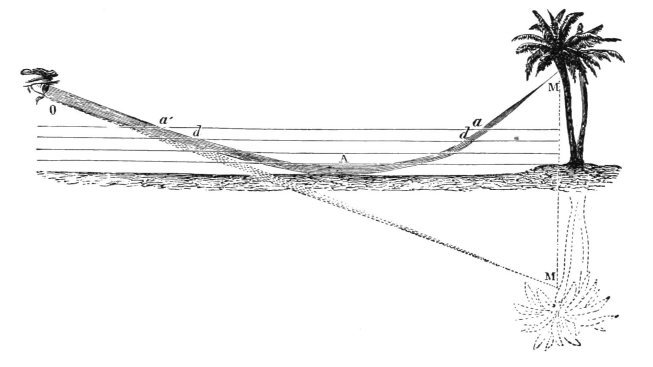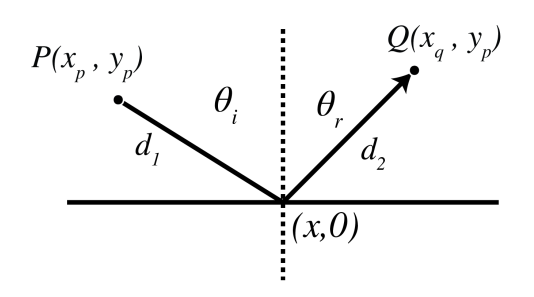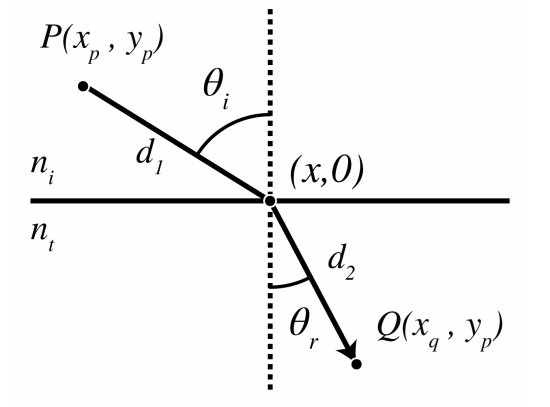2.4: Some Consequences of Fermat’s Principle
- Page ID
- 57072
Homogeneous matter
In homogenous matter, the refractive index is constant and therefore paths of shortest OPL are straight lines. Hence in homogeneous matter rays are straight lines.
Inhomogeneous matter
When the refractive index is a function of position such as air with a temperature gradient, the rays bend towards regions of higher refractive index, leading several well-known effects (see Figure \(\PageIndex{1}\) ).

Law of reflection
Consider the mirror shown in Figure \(\PageIndex{2}\) A ray from point P can end up in Q in two ways: by going straight form P to Q or alternatively via the mirror. Both possibilities have different path lengths and hence different travel times and hence both are local minima mentioned at the end of the previous section. We consider here the path by means of reflection by the mirror. Let the x-axis be the intersection of the mirror and the plane through the points P and Q and perpendicular to the mirror. Let the y-axis be normal to the mirror. Let (xP , yP ) and (xQ, yQ) be the coordinates of P and Q, respectively. If (x, 0) is the point where a ray from P to Q hits the mirror, the travel time of that ray is
\[\dfrac{n}{c}d_{1}(x)+\dfrac{n}{c}d_{2}(x)=\dfrac{n}{c}((x-x_{P})^2+y_{P}^2)^{1/2}+\dfrac{n}{c}((x_{Q}-x)^2+y_{Q}^2)^{1/2}, \nonumber \]
where n is the refractive index of the medium in y > 0. According to Fermat’s Principle, the point (x, 0) should be such that the travel time is minimum , i.e.
\[\dfrac{d}{dx}[d_{1}(x)+d_{2}(x)]=\dfrac{x-x_{P}}{d_{1}(x)}-\dfrac{x_{Q}-x}{d_{2}(x)}=0. \nonumber \]
Hence
\[\sin θ_{i}=\sin θ_{r}, \nonumber \]
or
\[θ_{r}=θ_{i}. \nonumber \]
where θi and θr are the angles of incidence and reflection as shown in Figure \(\PageIndex{2}\).
Snell’s law of refraction
Next we consider refraction at an interface. Let y = 0 be the interface between a medium with refractive index ni in y > 0 and a medium with refractive index nt in y < 0. Let (xP , yP ) and (xQ, yQ) with yP > 0 and yQ < 0 be the coordinates of two points P and Q are shown in Figure \(\PageIndex{3}\).

What path will a ray follow that goes from P to Q? Since the refractive index is constant in both half spaces, the ray is a straight line in both media. Let (x, 0) be the coordinate of the intersection point of the ray with the interface. Then the travel time is
\[\dfrac{n_{i}}{c}d_{1}(x)+\dfrac{n_{t}}{c}d_{2}(x)=\dfrac{n_{i}}{c}((x-x_{P})^2+y_{P}^2)^{1/2}+\dfrac{n_{t}}{c}((x_{Q}-x)^2+y_{Q}^2)^{1/2}. \nonumber \]
The travel time must be minimum, hence there must hold
\[\dfrac{d}{dx}[n_{i}d_{1}(x)+n_{t}d_{2}(x)]=n_{i}\dfrac{x-x_{P}}{d_{1}(x)}-n_{t}\dfrac{x_{Q}-x}{d_{2}(x)}=0. \nonumber \]
where the travel time has been multiplied by the speed of light in vacuum. Eq. (\(\PageIndex{6}\)) implies
\[n_{i}\sin θ_{i}=n_{t} \sin θ_{t}, \nonumber \]
where \(θ_i\) and \(θ_t\) are the angles between the ray and the normal to the surface in the upper half space and the lower half space, respectively (\(\PageIndex{3}\)).

Hence we have derived the law of reflection and Snell’s law from Fermat’s principle. In Chapter 1 the reflection law and Snell’s law have been derived by a different method, namely from the continuity conditions for the electromagnetic field components at the interface.


